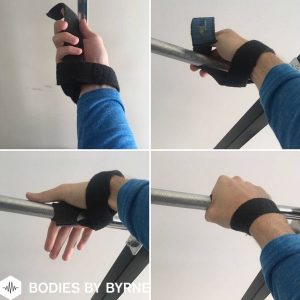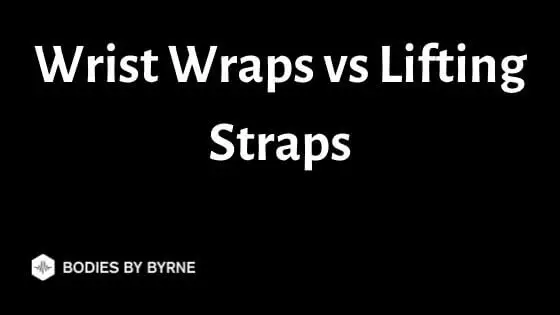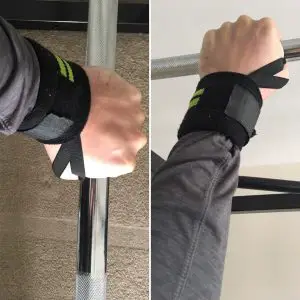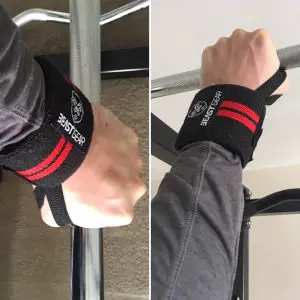__
As you move up the lifting ladder and go from a beginner in the gym to an intermediate and eventually advanced level lifter you will start to acquire additional lifting accessories as you go.
There is a range of equipment you’ll start to collect to aid in your lifting progress and quest to build a better body from foam rollers for soft tissue work, ab roller and mats for core work to a weightlifting belt to support your abdomen on heavy squats and deadlifts.
Once the weights you lift start to get heavier then some common accessories that you’ll purchase are lifting wraps and straps. Ignoring knee wraps, for this article I will cover wrist wraps and lifting straps because honestly people get confused and often either think they are the same thing or need one thing and mistakenly purchase the other!
Wrist wraps vs lifting straps? Wrist wraps are used to wrap around your wrist and provide joint support during any sort of heavy pressing. Lifting straps however, also wrap around your wrist but also around the bar and are used to support a weak grip during any sort of heavy pulling.
I can remember at 15 years old my first workout related purchase (besides some York at home weight sets) was a pair of weightlifting gloves. At the time I had minimal grip strength so would ruin my hands with calluses from not being able to grip the bar with any sort of strength.
When I put them gloves on I genuinely thought “yeah, I’m a serious weightlifter and people will recognise that now that I’ve got these gloves on”. Ok maybe that is a slight over exaggeration but at the same time it is also slightly true.
People these days buy weightlifting accessories for show rather than purpose and often don’t actually know what the use is. They’ve likely seen a bodybuilder or YouTuber with them and have just purchased an item because it’s what the big guys use.
I’ve already discussed what I believe to be gym bag essentials before as well as must have training accessories but this particular topic often causes some confusion.
Therefore in this article I’m going to point out the difference between wrist wraps and lifting straps and lay out when is the best time to use them and whether or not you even need them.
Wrist Wraps vs Lifting Straps
Both a wrist wrap and lifting strap (sometimes referred to as a wrist strap) go around the wrist so it’s very easy to see why some people might get the two confused. The same is true for knee wraps vs knee sleeves however that is a topic for another article.
The two however provide completely different functions and therefore it’s important to understand what you are actually buying and why you are buying it before purchasing one.
What Are Wrist Wraps
Wrist wraps are used to provide support for the wrist joint during heavy pressing movement. They wrap around the wrist to keep it tight and secure and offer a layer of safety when pressing due to possibility of the wrist overextending.
Wrist wraps can actually come in different sizes which are not commonly known and each size will provide a different layer of joint support for the wrist. As you can see below I have two sets of wrist wraps that I’ll use interchangeably.
A regular set (like these from Amazon) can be used for moderate pressing (they don’t provide a high level of tension around the joint but still keep it secure) and an XL set (like a Rogue set) which offer a much greater degree of tension, pressure and support for heavy pressing.
The key difference between the two being that the black and green colored set are shorter and in length and not as thick. The black and red sets are much longer in length and thicker meaning they can be wrapped around the wrist more times increasing the tension around the joint.
What I will point out is these should not be worn at all times, I’ve mentioned before that accessories should only be used for your top sets (ie heaviest sets) so that you can still build up a good base of strength without relying on accessories.
If you wear them all the time then they can become a crutch and you will become over reliant on them and lose strength and stability which are essential for lifting longevity and progress.
Are Wrist Wraps Good for Lifting
Wrist wraps are excellent tools to use for lifting, especially if you have small/weak wrist joints. Some people you will see are genetically built to lift and have larger and more dense bone structures meaning they can handle the stress that heavy lifting places on the joints.
For others (myself included) with much smaller joints that are not necessarily built to lift heavy weights then they can be crucial in providing support and safety when attempting heavy presses.
We all know that to continue to grow muscle you need to get progressively stronger over time and while your muscles, ligaments and tendons can adapt and grow, you joints to not have that same advantage.
In fact it is quite the opposite, the more weight you lift the more susceptible your joints become to strain and injury because they actually become more unstable. Your shoulder being a ball and socket joint as an example is the most vulnerable to heavy weight which is why you see so many shoulder related injuries.
The more mobile a joint is the more vulnerable it becomes. The wrist is less mobile but can still move in a variety of directions meaning it’s important to offer support during heavy presses.
When to Use Wrist Wraps
I’ve mentioned this a few times now but wrist wraps should only be used during heavy pressing movements like a bench press or overhead press.
The reason for this is because the wrist can be placed in a more vulnerable position and you can wrist over extending it which could then lead to injury. A wrist wrap will provide that much needed support and tension around the joint to keep it locked into position and minimize the risk of any injury.
Many people think that they should be used as a way to lift more weight, this tis because a firm and secure joint is a stronger joint. People who use knee wraps to squat and leg press can usually use more weight because the joint is locked in a stable position allowing for maximum transfer of energy.
It’s important however to ensure you have a solid support base before attempting this though which is why I recommend using a wrist wrap only when you go above 80% of your 1 rep max for a lift. If you use a wrist wrap too frequently then you will never build up the smaller muscles around the wrist to support the joint which will in turn become a weakness.
What Are Lifting Straps
Lifting straps are straps that you loop around your wrist and then wrap around the bar to essentially lock the back in position when you grasp it and prevent it slipping out of your hand due to a weak grip.
Lifting straps are excellent accessories to target larger muscle groups like the back without having your smaller muscle groups (forearms and grip) preventing you from fully working the muscle group.
Lifting straps are incredibly cheap to buy (£10/$10) and have an incredible upside when using them. Sheik would be my recommendation for a basic lifting strap offering 1000lb lifting capacity.
The best lifting straps I’ve ever owned are the Sheik padded lifting straps which are a hybrid between a lifting wrap and strap.
Why Do Lifters Use Straps
The main reason why lifters use straps is because their grip strength is often a limiting factor when it comes to heavy pulling movements like a deadlift or rowing variations.
Using the deadlift as an example your back muscles are the primary muscle groups that will be active during a deadlift (as well as the leg muscles to a degree) and are all very large muscle groups.
With this in mind most people have a strong deadlift and can work up to a 2 x bodyweight deadlift in their first year of training. That weight to body weight ratio is not achievable in any other compound lift except for maybe the squat if you have ideal body mechanics for it.
Therefore the strength potential is great but oftentimes you grip, controlled by the smaller forearm muscles is usually a limiting factor. There are specific hand techniques to try to minimize this like a hook grip and mixed grip in order to prevent the bar slip but it’s always a limiting factor.
This is true in even the strongest of lifters and usually it’s rare to see someone perform a heavy deadlift without the use of lifting straps. Lifting straps essentially eliminate the need for grip strength by locking your wrist to the bar.
This is the main reason lifters use straps, by removing the possibility of your grip failing you can know lift a max lift with your only limit being how much you can physically lift for the given pulling exercise.
Do Lifting Straps Make a Difference
Lifting straps make a huge difference if you have a weak grip. I like to use myself as an example again because I’ve tried and tested all these methods.
I’ve got long arms which are good for leverage and essentially make me a good puller. I’m significantly stronger in my pulling exercises than in my pressing exercises, it’s not even comparable. I can load up any hammer strength row and crank out the reps.
Put me on a pressing exercise though and I’m lucky to pass for having an average level of strength. With that said I soon noticed after a few years training that my grip was holding me back when it came to rows and shrugs because I’d end up dropping the dumbbell or barbell before my back muscles were fatigued.
This was incredibly frustrating and I used to wrap towels around the bars and use all kind of hacks to try and prevent my grip from giving out so often.
** Interesting fact/body hack – to improve grip strength you should squeeze the bar as hard as you can but then tense your abs at the same time. That’s not all though because then you want to tense and contract your glute muscles at the same time as well.
Doing this creates a neuromuscular connection and drastically increases grip strength. Test it on a barbell or a friends forearm if you don’t believe me, just make sure you let them know what you are doing and stop before hurting someone.
Now I never knew that handy little hack before but it still wouldn’t have made much of a difference, my grip strength was significantly less than would my weight potential was. Therefore when I finally came across lifting straps it was a game changer.
I’m not exaggerating when I say I jumped from a 50kg/110lbs dumbbell row to 80kg/176lbs within a few weeks. Now that my grip was not a limiting factor the weights flew up by more than 50% for most of my pulling exercises.
This will of course be different for most people but there is definitely room to significantly increase your weights and start to fatigue your larger muscle groups by making use of lifting straps. Again though I only recommend these for your top sets.
Grip strength is important as a reflection of full body strength and therefore you want to do 80% of your workouts without the use of these accessories. They are only needed to push the limits on your very top sets and stimulate muscle growth.
For an external take on the benefits of lifting straps you can check out this article.
How to Use Lifting Straps
Lifting straps are very simple to use, you create a loop and place that your hand through it so that it is secured around your wrist and then wrap the lengthened end around the bar.
This very basic image shows how simple it is to use.

Summary
As you can see there is a significant difference between wrist wraps and lifting straps. A wrist wrap is used to support the wrist joint during heavy pressing movements whereas a lifting strap is used to support grip strength during heavy pulling movements.
I would say that neither are essential but once you start getting more advanced in your training they can certainly help support your training with marginal benefits. Once you are at an advanced stage these small margins are the difference between gaining a few additional pounds of muscle or seeing no gain at all!
Hopefully you now know the difference between the two and when you should be using them. Don’t get caught being the person using a lifting strap during the bench press (I’ve seen people do this, I’ve done it myself and can offer no explanation why!).
What Next
If you are looking to make changes to your physique by either losing body fat, building muscle or looking to maintain a lean physique then sign up to my weekly newsletter below. Each week I send out actionable tips to help you lose that extra 1lb of fat or build that extra 0.5lb of muscle mass on a weekly basis.
If you sign up now you’ll also receive my 28 day body recomp program completely Free. This ebook will be sent straight to your inbox and will provide an intense 28 day program aimed at helping you lose up to 8lbs of body fat whilst also building 2lb-4lb of lean muscle mass in just 4 weeks.
Don’t worry if you’re not ready for an intense program just yet, my weekly newsletter will give smaller tips that when implemented daily, will stack up over time and see you transform your body with seemingly minimal effort!


